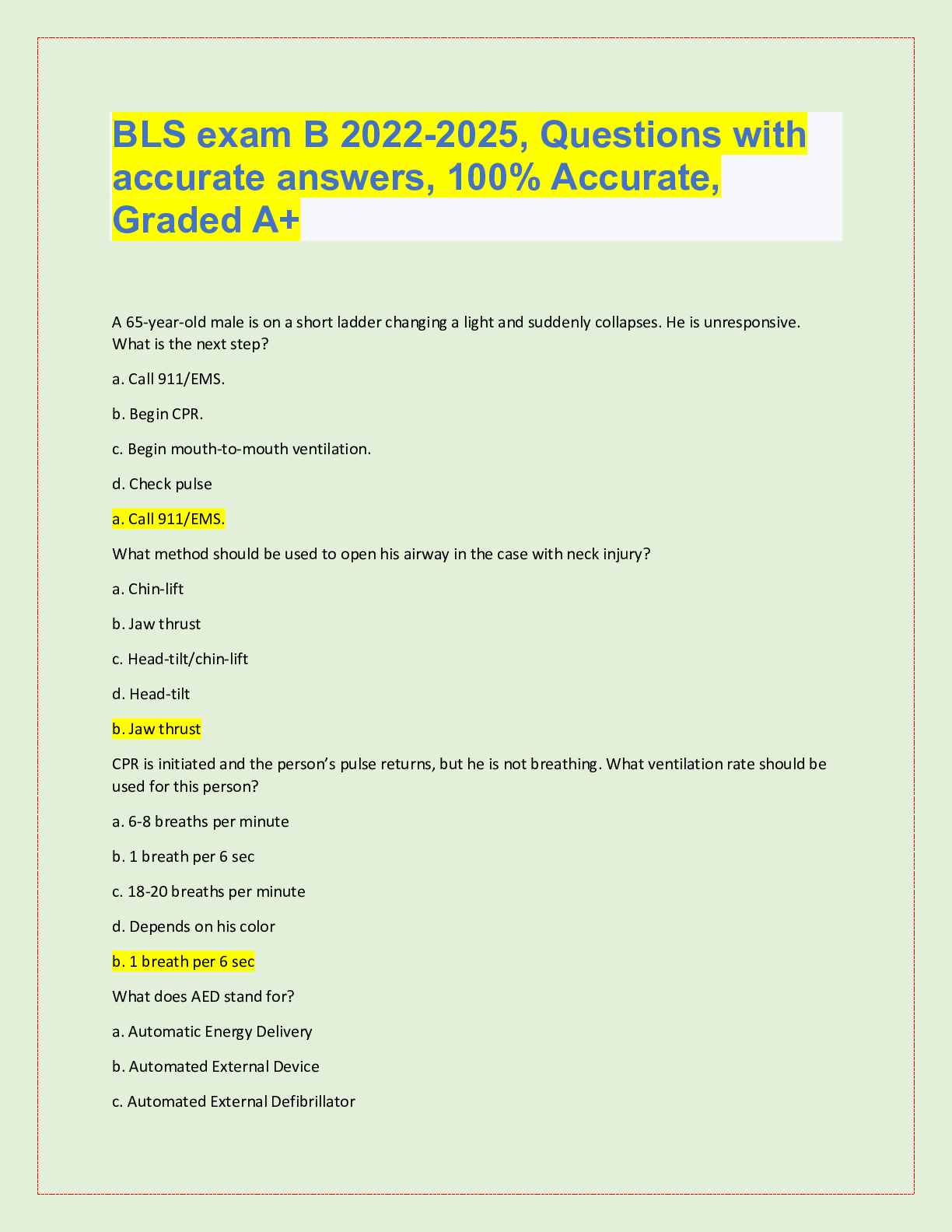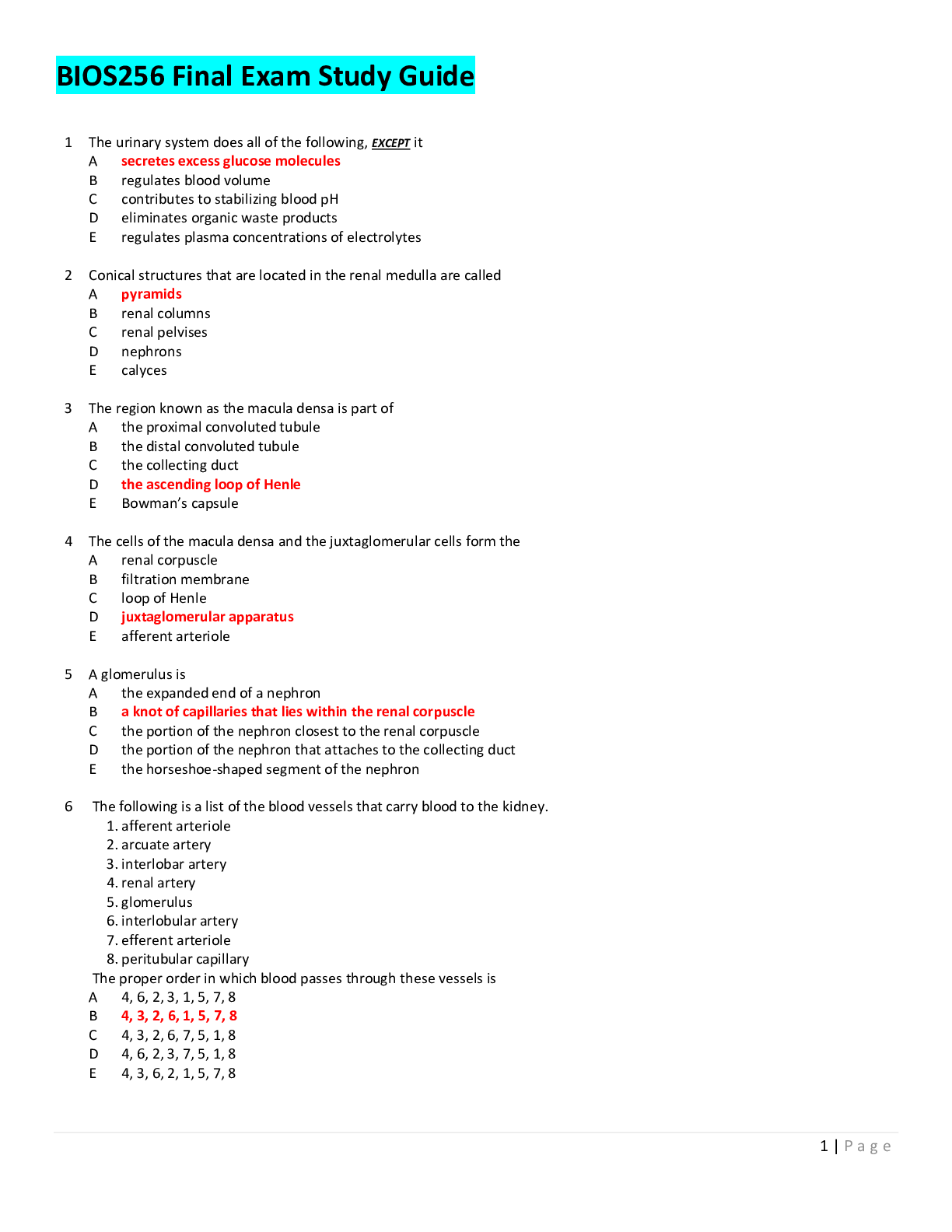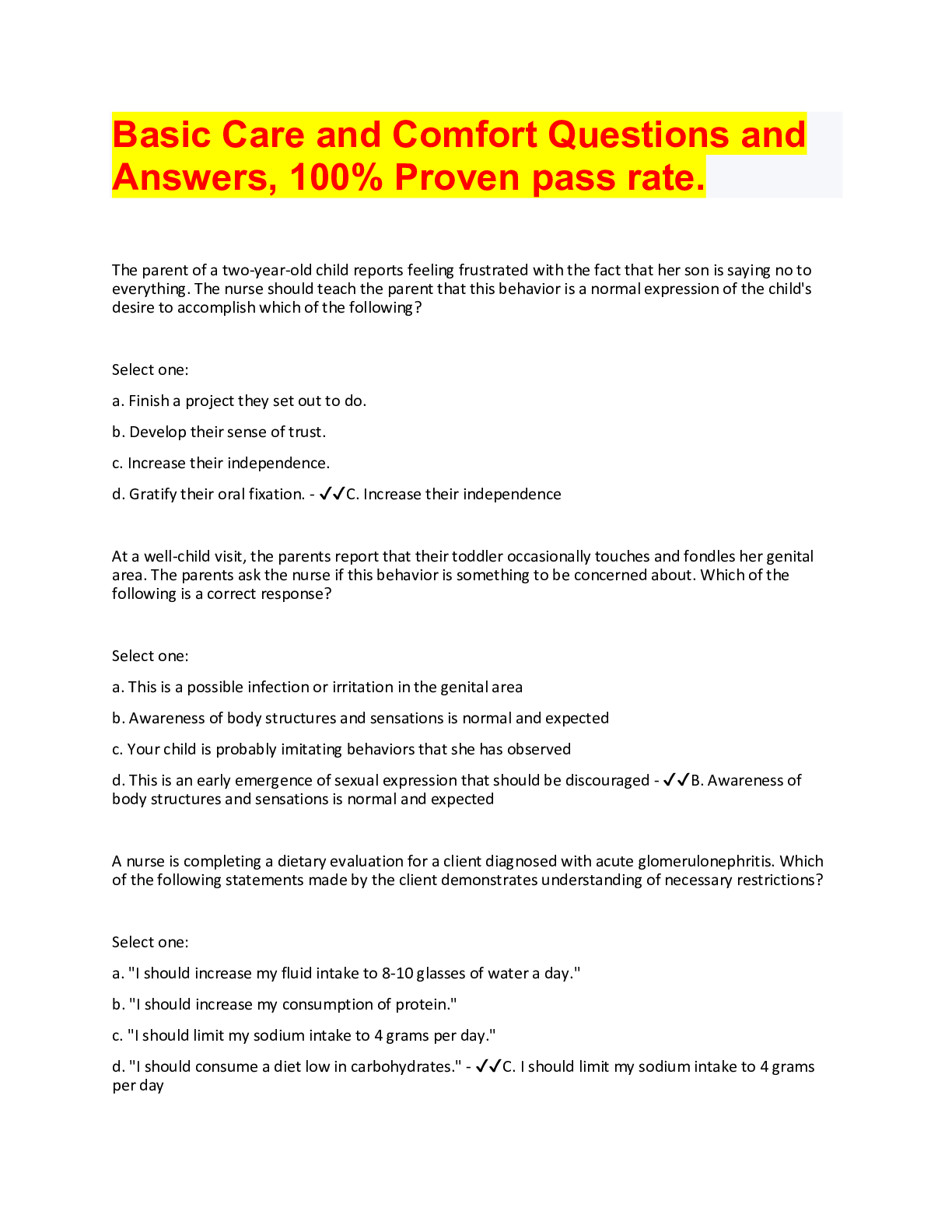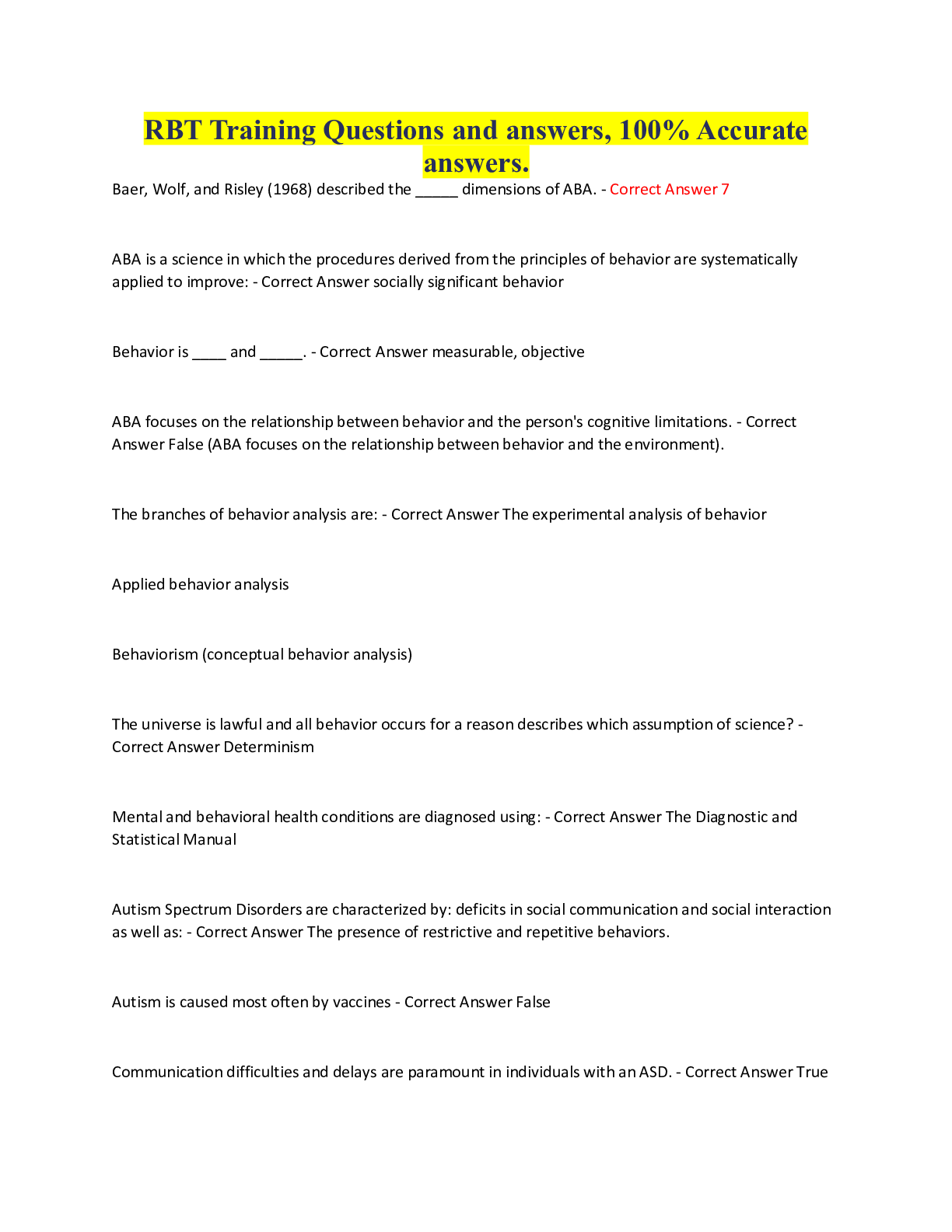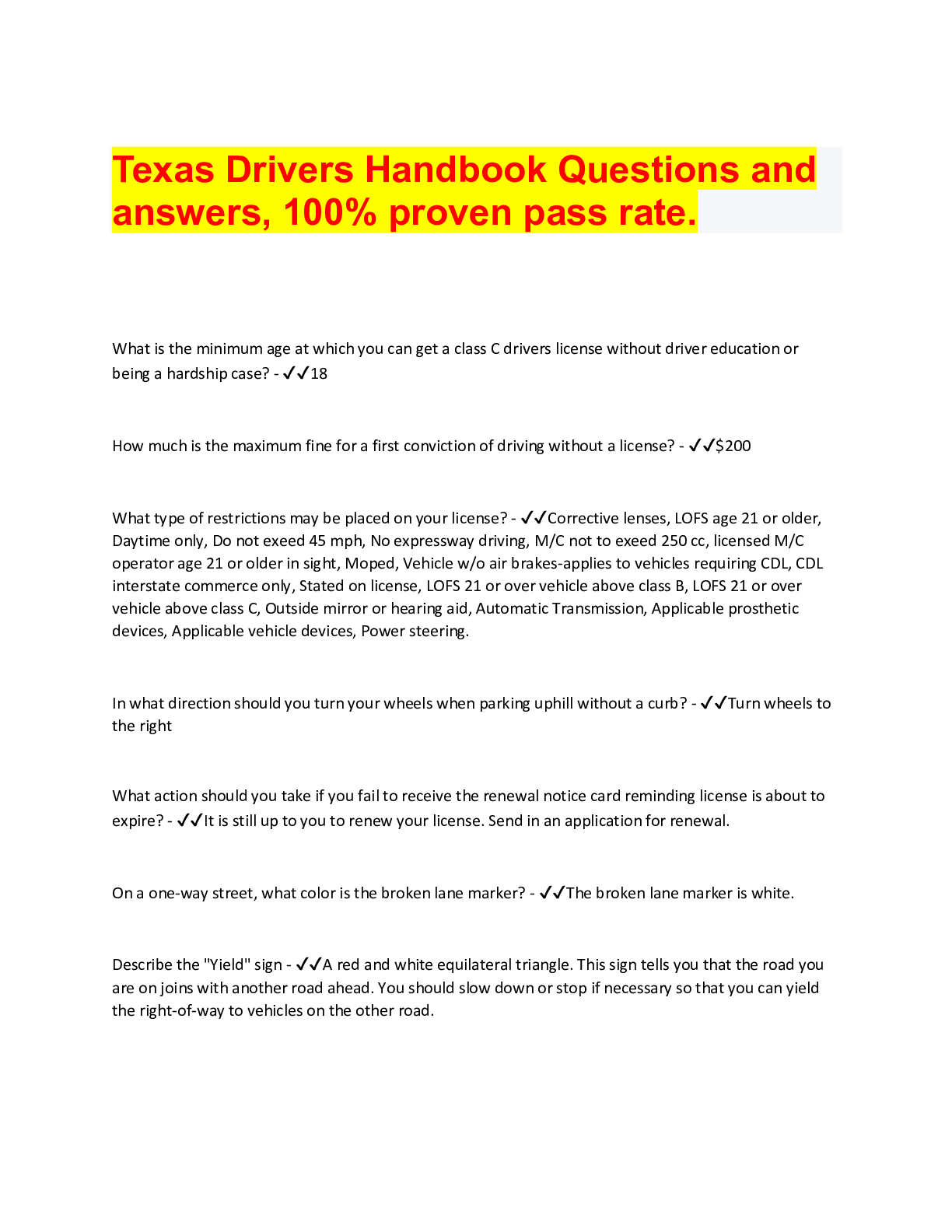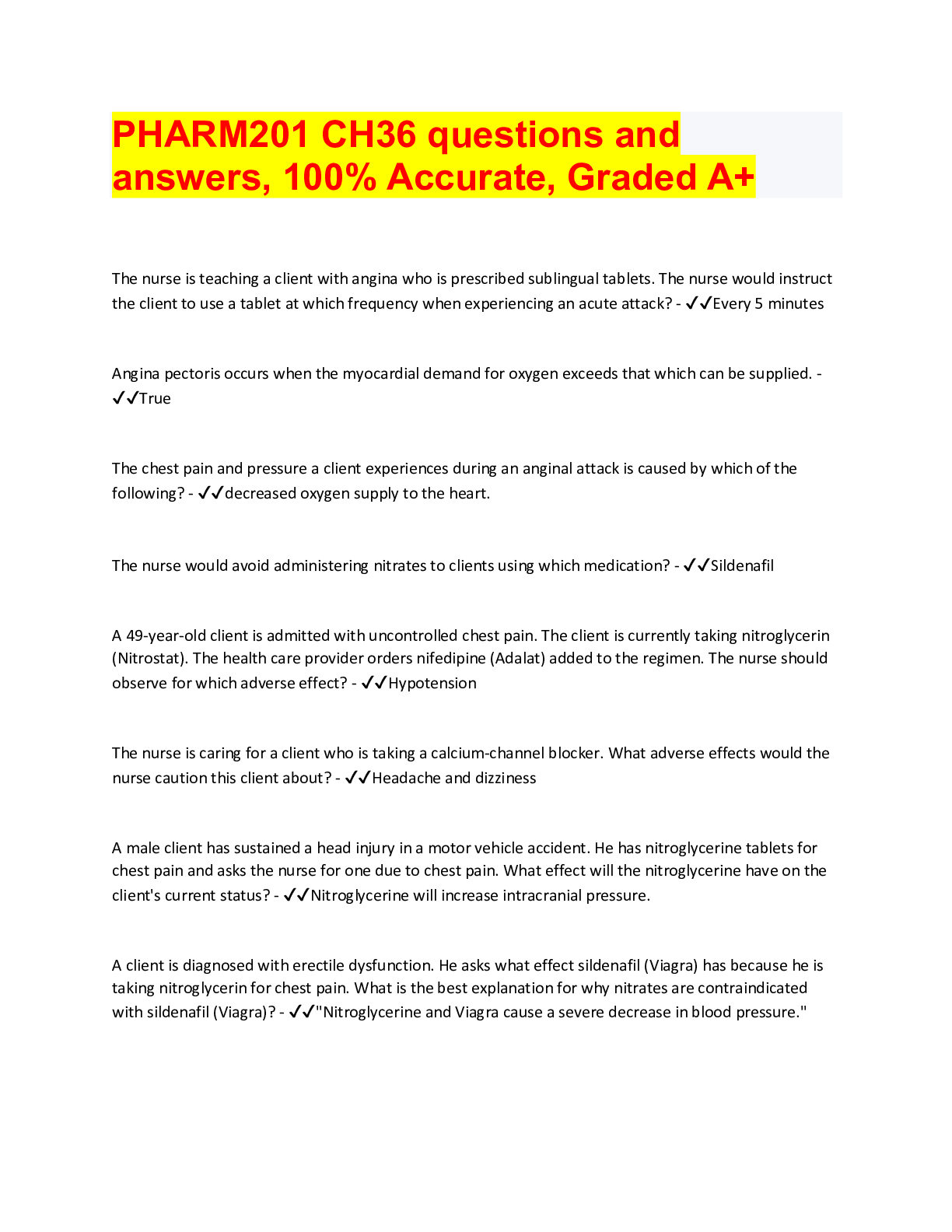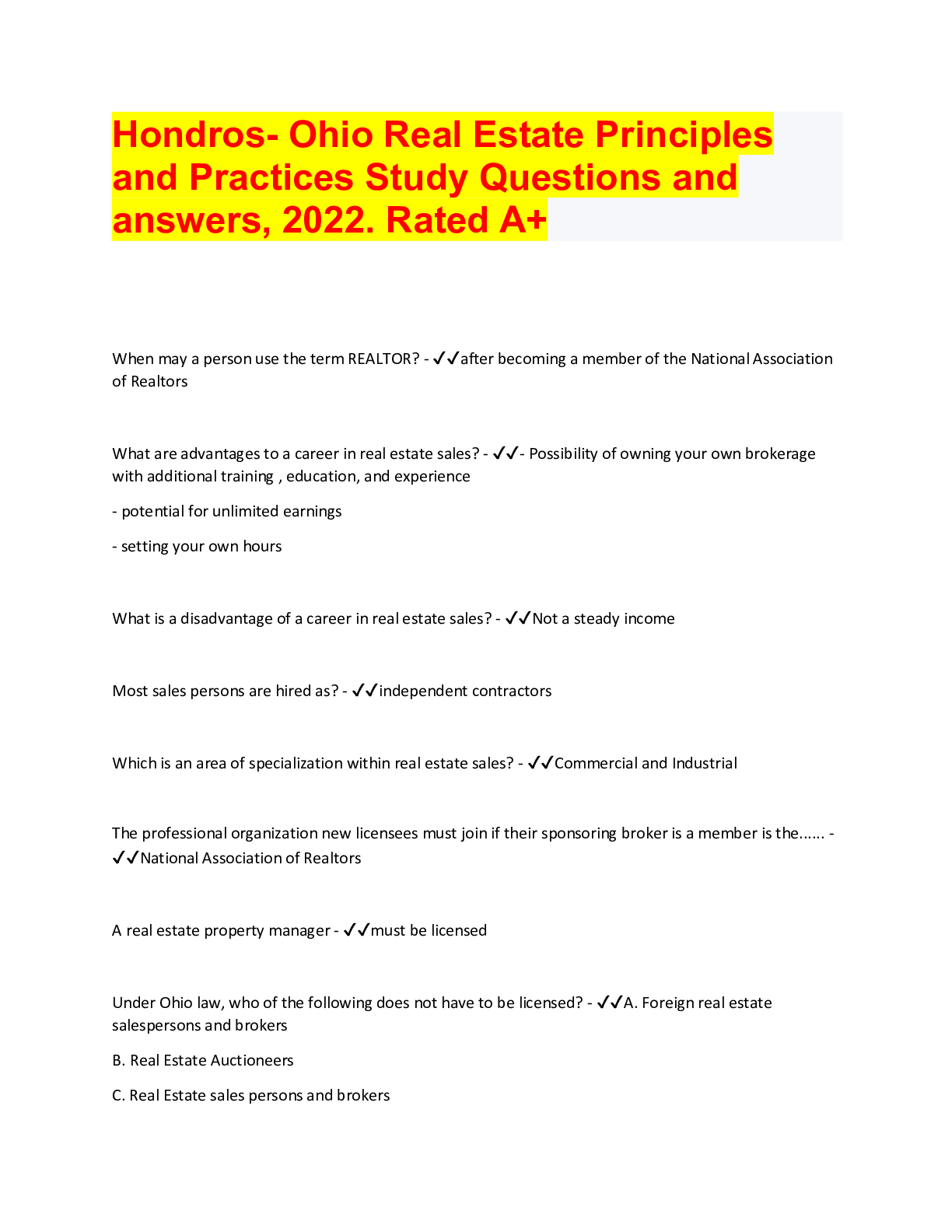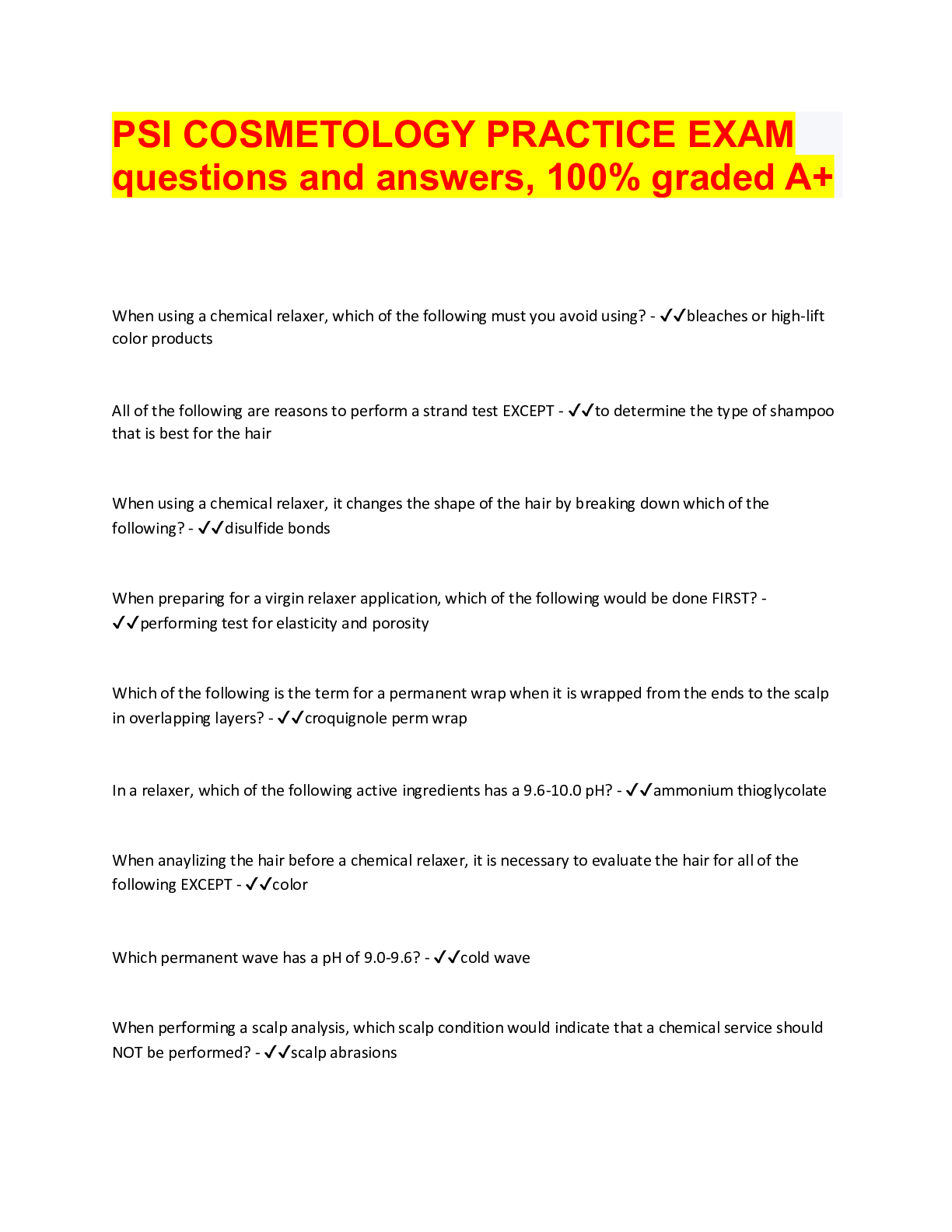Psychology > QUESTIONS & ANSWERS > WGU C180 Full Review, All Question sections and answers, 100% Verified. Classical conditioning (All)
WGU C180 Full Review, All Question sections and answers, 100% Verified. Classical conditioning
Document Content and Description Below
WGU C180 Full Review, All Question sections and answers, 100% Verified. Classical conditioning Learning to associate 2 stimuli together, which leads to an organism anticipating future events. Exam... ple: Ivan Paplov studied salivation in dogs as a precursor to digestion. Unconditioned stimulus Stimulus that automatically triggers a response naturally. Unlearned. Unconditioned response Naturally occuring, unlearned response to an unconditioned stimulus. Unlearned. Conditioned stimulus Originally neutral stimulus that triggers a response after an association with an unconditioned stimulus is formed. Learned. Conditioned response Learned response to a stimulus that was originally neutral, but is now conditioned. Extinction Occurs when the unconditioned stimulus is no linger paired with the conditioned stimulus. Make the behavior go away. Generalization Stimuli similar to the conditioned stimulus will also elicit the conditioned response. Avoid things that are similar to things that have hurt us. Operant conditioning Controlling behavior through consequences. Behavior strengthened by reinforcement and weakened by punishment. Positive reinforcement Increases behavior by presenting a positive stimulus. Adding Example: giving dog a treat to roll over Negative reinforcement Increases behavior by stopping a negative stimulus. Subtracting Example: you buy your child a toy in the store and he stops crying. This will increase your toy buying behavior. Primary reinforcer Does not have to be learned. Satisfies a biological need. Food. Water. Similar to unconditioned stimuli. Secondary reinforcer Has to be learned. These can get us the primary reinforcers. Good grades. Money. Similar to conditioned stimuli. Reinforcement schedules Continuous and partial Continuous reinforcement A behavior is reinforced every time it occurs. For example if you give your child a candy bar every time he cleans his room. Partial reinforcement A behavior is reinforced only part of the time it occurs. Example: you gave your child a candy bar every so often after he cleans his room. Note: this type of schedule is much more difficult to extinguish Partial reinforcement schedule types Ratio and Interval Ratio Reinforcement that occurs after a number of responses occur - response Interval Reinforcement occurs after an amount of time passes - time Fixed-ratio A knowable pattern. You get your reinforcer after a specific number of responses. For example: after purchasing five sandwiches, you get one free at your favorite deli Variable-ratio Random pattern. You get your reinforcer after an unpredictable number of responses occur. For example: playing the lottery; playing a slot machine Fixed-interval After a specified amount of time has passed, you receive a reinforcer for your response. Example: checking to see if your mail has come, a pay period. Variable-interval A random amount of time has passed and you never know when you're going to receive a reinforcer for your response. Example: checking your Facebook status for likes. Checking your email. Note: variable schedules are much harder to stop once they have been put in place. Positive punishment Adding something unpleasant to decrease or stop the behavior. Example: corporal punishment; spraying water on the cat. Negative punishment Stop the behavior by the subtraction of something positive. For example: you come in late after curfew and your parents take away your car keys. Observational learning Learning by observing others who are modeling behaviors. Vicarious reinforcement Watching others receive reinforcement for their behavior. Example: watching a movie in which a criminal is rewarded with money for committing a crime. Vicarious punishment Watching someone receive a punishment for their behavior. Example: watching a movie in which a criminal goes to jail for committing a crime. Social psychology Social psychologists focus on how the situation contributes to our behavior. It is a blend of sociology and psychology and focuses on how individuals change when they're in the presence of others and certainly in the presence of groups. attribution theory We may attribute behavior to the persons personality (dispositional attribution) or... or we can attribute it to the situation or surroundings (situational attribution). Fundamental attribution error This occurs when we over estimate a persons disposition and under estimate the situation. Example: what do we think of parents who yell at their children in public? Cognitive dissonance And uncomfortable feeling that occurs when your attitude and your behaviors are in congruent. This could include rationalization. This could also include a revision of your memories of an event. This is when you are judging yourself for an error you have made. For example: losing your child at the zoo Social influence This can include family, school, work, community, church, friends and social media. It is looking at how our environment influences our believes and our behavior. Obedience - Stanley Milgram An experiment conducted to see when we are most likely to obey commands. Participants were told that every time someone got an answer wrong they were supposed to shock them with this machine and the machine went all the way up to the danger zone at 450 V. 65% of his first sample deliver the shocks all the way to 450 V. Obedience experiment results We see obedience at its highest levels when: The person giving us orders is in close proximity and is perceived to be an authority figure. Authority figure has the backing of a prestigious institution. The victim is depersonalized. There are no role models doing opposite. Social facilitation The presence of others contribute to an increase in our performance. Example: running a 5K. Example: home-field advantage in football Social loafing Some group members decrease their contributions especially of others pick up their work Deindividuation Diminished responsibility when in an anonymous group. Losing yourself. Like in a riot. Group polarization Our beliefs become stronger when we read confirming information or we interact with like-minded people. Example: politics Groupthink When a unanimous decision is the goal; the group Magno or disconfirming evidence. Example: shuttle Challenger explosion in 1986. Prejudice Negative attitude toward a group of people that is often unjustifiable. Beliefs: stereotypes, emotions: hostility or fear, behavior: discrimination Just world phenomenon Good deeds are rewarded and bad deeds punished. Karma. Ingroup vs outgroup We tend to favor the group we belong to. Football teams. Us vs them. Vivid cases We tend to remember extreme cases that may cloud reality. Sensational news on social media. Is this the norm or just being out there because it is not the norm? Frustration aggression hypothesis When we have a blocked goal or experience unpleasant things, we may become aggressive. Verbal or physical. Relative deprivation We feel entitled to certain things because others have them. Example: smart phones, designer clothes Attraction Things that fuel attraction. Proximity. Being close. Physical attractiveness. Similarities. Romantic love Love starts out as being passionate. This is physical and may be short lived. Companionate Love is deep and affectionate attachment. Long lasting. Altruism Helping others without anything in return. Bystander affect We are less likely to help someone who is in danger when there are others around. Kitty Genovese. Order for memory processing Encoding, storage, and retrieval Example of explicit memory Studying for an exam. Memory Encoding, storing, and retrieving information. Measured by recall, recognition, and relearning. Sensory memory Lasts approx 2 seconds. Iconic-picture or echoic-sound. Short term memory 7 +/- 2 items as long as we are rehearsing them. Phone numbers. Grocery list. Like the computer desktop. Long term memory Limitless and permanent. Like a hard drive. Working memory Mental workspace. Correlated with verbal intelligence and reading comprehension. Explicit memory Declarative memory. Able to declare these memories. Involves effort processing and conscious awareness. Implicit memory Nondeclarative memory. Involves automatic processing but not conscious awareness. Reading even when letters are missing. Habits. Procedural memories. It's just like riding a bicycle. Encoding - chunking Breaking material down into chunks or sections to make it easier to remember. Phone numbers and social security numbers are chunked. Encoding - mnemonics Memory aids that typically use visual imagery to increase retention. Example: acronyms. Distributed practice Space out study materials over time. Long term retention. Massed practice Cramming information into your head over a short amount of time. Not good for long term. Testing effect Test yourself while studying rather than just reading the material. This will help with retrieval. Context dependent learning Context during study should be the same as when you test. State dependent learning Same mental state during study and testing. Flashbulb memory Events that are salient and typically include a strong emotional component. Serial-position effect You remember items at the beginning (primacy) and the end (recency) better than the ones in the middle. Anterograde amnesia Inability to recall new information. Can not form new memories. 50 first dates. Usually caused by trauma. Can't recall after the trauma. Retrograde amnesia Inability to recall old information. Can't remember what occurred before the trauma. Proactive interference You can't teach old dogs new tricks. You try to learn something new but keep going back to the old information. Example: change your password but then put it the old password. Retroactive interference Converted to new information. You master the new info and then you can't remember any of the old information anymore. Can't remember old addresses or phone numbers. Intelligence the ability to learn from experience, to use information, to understand things, solve problems and be adaptable. Achievement tests Measures knowledge you have. K-12 tests Aptitude tests Used to predict future success in an area. ASVAB. Intelligence tests Wais and Wisc Reliability Consistency of the test Validity The test is measuring what we want it to measure. Fluid intelligence Ability to reason and think abstractly in a quick manner. Decrease as we age. Crystalized intelligence Increases with age. Knowledge base. Heritability How much of an intelligence test score variation can be attributed to genetic variation 50-80 percent. The rest is environmental. Fixed mindset Intelligence is set and we can't do anything about it Growth mindset You believe that you can change and have the potential to change Psychological disorder Ongoing dysfunctional patterns of thought, emotion, and behavior that causes significant distress, impairs a persons normal functioning, and is considered deviant and that person's culture or society Three components of psychological disorder Biological, psychological, and social. Diagnosis Observations of behaviors by professionals. Use DSM-V manual [Show More]
Last updated: 2 years ago
Preview 1 out of 15 pages

Buy this document to get the full access instantly
Instant Download Access after purchase
Buy NowInstant download
We Accept:

Also available in bundle (1)

WGU C180 BUNDLE. VERIFIED
WGU C180 Units, Top Exam Questions and answers, 100% Accurate, graded A+
By Topmark 2 years ago
$30
13
Reviews( 0 )
$9.00
Can't find what you want? Try our AI powered Search
Document information
Connected school, study & course
About the document
Uploaded On
Mar 13, 2023
Number of pages
15
Written in
Additional information
This document has been written for:
Uploaded
Mar 13, 2023
Downloads
0
Views
130

